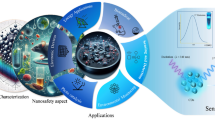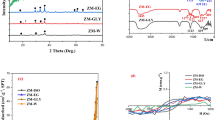Abstract
This study describes the development of an electroanalytical methodology using square-wave voltammetry (SWV) to quantify benzoylecgonine (BE) in synthetic urine samples using a boron-doped diamond electrode. Due to the oxidation of the tertiary amine present in the tropane group, it was possible to observe an irreversible oxidation process, with a maximum oxidation peak around + 2.10 V, in an acidic medium. Initially, the design of experiments (DoE) was applied to optimize the SWV parameters using a central composite design. All DoE analyses occur in a solution of H2SO4 0.5 mol L−1 as a supporting electrolyte and a fixed concentration of 0.20 mmol L−1 of BE; the optimal parameters found were 6.023 mV for step potential, 87.045 mV for modulation amplitude, and 30.795 Hz for frequency. Performance characteristics were obtained after constructing the analytical curve, including a limit of detection of 1.20 μmol L−1, and a limit of quantification of 4.0 μmol L−1 within a linear working range from 4.93 to 154.20 μmol L−1, and a R2 of 99.76%. BE analysis was performed on a solution containing different proportions of synthetic urine and H2SO4, specifically 9:1, 6:4, and 3:7 (v/v) of acid and synthetic urine, respectively. Nevertheless, it was not possible to conduct a standard recovery test in ratios higher than 9:1 (v/v) of urine to acid due to a lack of response. In conclusion, this methodology offers a reliable approach for determining BE, an important analyte in forensic chemistry, and the DoE allows a comprehensive analysis of the performance parameters of the technique used.
Graphical abstract







Similar content being viewed by others
References
Medeiros KT, Maciel SC, De Sousa PF et al (2013) Social representations of the use and abuse of drugs among relatives of users. Psicol em Estud 18:269–279
Drug Market Trends: Cocaine Amphetamine-Type Stimulants (2021) United Nations Office on Drugs and Crime (UNODC), Vienna. https://www.unodc.org/unodc/en/data-and-analysis/wdr2021.html. Accessed 2 May 2024
Farias RF (2008) Introdução à Química Forense. Átomo, Campinas
Lizot LLF, da Silva ACC, Bastiani MF et al (2019) Simultaneous determination of cocaine, ecgonine methyl ester, benzoylecgonine, cocaethylene and norcocaine in dried blood spots by ultra-performance liquid chromatography coupled to tandem mass spectrometry. Forensic Sci Int 298:408–416. https://doi.org/10.1016/j.forsciint.2019.03.026
Mafra G, Birk L, Scheid C et al (2020) A straightforward and semiautomated membrane-based method as efficient tool for the determination of cocaine and its metabolites in urine samples using liquid chromatography coupled to quadrupole time-of-flight-mass spectrometry. J Chromatogr A 1621:461088. https://doi.org/10.1016/j.chroma.2020.461088
Menotti VS, Scanferla DTP, de Oliveira KO et al (2020) Validation of a method for simultaneous analysis of cocaine, benzoylecognine and cocaethylene in urine using gas chromatography-mass spectrometry. Brazilian J Pharm Sci 56:1–9. https://doi.org/10.1590/s2175-97902020000118664
Scanferla D, Sakurada J, Oliveira L et al (2021) Highly selective HF-LPME-GC-MS for cocaine and biotrabsformation products in human hair to monitor drug addicts. Quim Nova 44:921–928. https://doi.org/10.21577/0100-4042.20170737
Cardoso MS, Lanaro R, Dolores RC et al (2022) Determination of drugs of abuse in hair by LC–MS-MS: application to suicide attempts investigation. J Anal Toxicol 46:577–581. https://doi.org/10.1093/jat/bkab058
Lourencao BC, Brocenschi RF, Medeiros RA et al (2020) Analytical applications of electrochemically pretreated boron-doped diamond electrodes. ChemElectroChem 7:1291–1311. https://doi.org/10.1002/celc.202000050
Komorsky-Lovrić Š, Gagić S, Penovski R (1999) Voltammetric determination of benzoylecgonine. Anal Chim Acta 389:219–223. https://doi.org/10.1016/S0003-2670(99)00091-4
Pavlova V, Mirčeski V, Komorsky-Lovrić Š et al (2004) Studying electrode mechanism and analytical determination of cocaine and its metabolites at the mercury electrode using square-wave voltammetry. Anal Chim Acta 512:49–56. https://doi.org/10.1016/j.aca.2004.02.035
Eissa S, Almthen RA, Zourob M (2019) Disposable electrochemical immunosensor array for the multiplexed detection of the drug metabolites morphine, tetrahydrocannabinol and benzoylecgonine. Microchim Acta 186:523. https://doi.org/10.1007/s00604-019-3646-8
Freitas JM, Ramos DLO, Sousa RMF et al (2017) A portable electrochemical method for cocaine quantification and rapid screening of common adulterants in seized samples. Sensors Actuators B Chem 243:557–565. https://doi.org/10.1016/j.snb.2016.12.024
Bilge S, Dogan-Topal B, Gürbüz MM et al (2022) Recent advances in electrochemical sensing of cocaine: A review. TrAC Trends Anal Chem 157:116768. https://doi.org/10.1016/j.trac.2022.116768
Fatibello-Filho O, Silva AT, De Moraes FC, Silva E (2022) Eletroanálises: aspectos teóricos e práticos. EdUFSCar, São Carlos
Andrade LS, Salazar-Banda GR, Rocha-Filho RC, Fatibello-Filho O (2011) Cathodic pretreatment of boron-doped diamond electrodes and their use in electroanalysis. Synthetic Diamond Films. Wiley, pp 181–212
Oliveira SCB, Oliveira-Brett AM (2010) Voltammetric and electrochemical impedance spectroscopy characterization of a cathodic and anodic pre-treated boron doped diamond electrode. Electrochim Acta 55:4599–4605. https://doi.org/10.1016/J.ELECTACTA.2010.03.016
Yagi I, Notsu H, Kondo T et al (1999) Electrochemical selectivity for redox systems at oxygen-terminated diamond electrodes. J Electroanal Chem 473:173–178. https://doi.org/10.1016/S0022-0728(99)00027-3
Suffredini HB, Pedrosa VA, Codognoto L et al (2004) Enhanced electrochemical response of boron-doped diamond electrodes brought on by a cathodic surface pre-treatment. Electrochim Acta 49:4021–4026. https://doi.org/10.1016/j.electacta.2004.01.082
Muzyka K, Sun J, Fereja TH et al (2019) Boron-doped diamond: current progress and challenges in view of electroanalytical applications. Anal Methods 11:397–414. https://doi.org/10.1039/C8AY02197J
Deroco PB, Vicentini FC, Oliveira GG et al (2014) Square-wave voltammetric determination of hydroxychloroquine in pharmaceutical and synthetic urine samples using a cathodically pretreated boron-doped diamond electrode. J Electroanal Chem 719:19–23. https://doi.org/10.1016/j.jelechem.2014.01.037
Macrino C de J, dos Santos NA, Conceição N dos S, et al (2024) Isolation and characterization of reference standard candidates for cocaine and benzoylecgonine obtained from illicit substances seized. J Forensic Sci 69:1025–1034. https://doi.org/10.1111/1556-4029.15502
Asturias-Arribas L, Alonso-Lomillo MA, Domínguez-Renedo O, Arcos-Martínez MJ (2014) Sensitive and selective cocaine electrochemical detection using disposable sensors. Anal Chim Acta 834:30–36. https://doi.org/10.1016/j.aca.2014.05.012
Rocha DP, Dornellas RM, Nossol E et al (2017) Electrochemically reduced graphene oxide for forensic electrochemistry: detection of cocaine and its adulterants paracetamol, caffeine and levamisole. Electroanalysis 29:2418–2422. https://doi.org/10.1002/elan.201700437
Abedul MTF, Rodríguez JRB, García AC, Blanco PT (1991) Voltammetric determination of cocaine in confiscated samples. Electroanalysis 3:409–412. https://doi.org/10.1002/elan.1140030427
Mocak J, Bond AM, Mitchell S, Scollary G (1997) A statistical overview of standard (IUPAC and ACS) and new procedures for determining the limits of detection and quantification: application to voltammetric and stripping techniques (Technical Report). Pure Appl Chem 69:297–328. https://doi.org/10.1351/pac199769020297
Benedito da Silva O, Machado SAS (2012) Evaluation of the detection and quantification limits in electroanalysis using two popular methods: application in the case study of paraquat determination. Anal Methods 4:2348. https://doi.org/10.1039/c2ay25111f
Laube N, Mohr B, Hesse A (2001) Laser-probe-based investigation of the evolution of particle size distributions of calcium oxalate particles formed in artificial urines. J Cryst Growth 233:367–374. https://doi.org/10.1016/S0022-0248(01)01547-0
Rosa TR, Rodrigues JGA, de Ferreira RQ (2016) Use of experimental planning for optimization of a procedure for simultaneous voltammetric determination of metals Zn, Cd, Pb and Cu free in coconut water. Quim Nova 39:8–14. https://doi.org/10.5935/0100-4042.20160004
de Barros Neto B, Scarminio IS, Bruns RE (2001) Como fazer experimentos. Editora Unicamp, Campinas
Baatache O, Derbal K, Benalia A et al (2024) Use of Pine cone as bio-coagulant for heavy metal removal from industrial wastewater: use of Box-Behnken design. Ind Crops Prod 210:118185. https://doi.org/10.1016/j.indcrop.2024.118185
Muzetti Ribeiro MF, da Cruz Júnior JW, Dockal ER et al (2016) Voltammetric determination of cocaine using carbon screen printed electrodes chemically modified with uranyl Schiff base films. Electroanalysis 28:320–326. https://doi.org/10.1002/elan.201500372
Ferreira B, Duarte LO, Oiye ÉN et al (2020) A simple and fast method to detect freebase cocaine in artificial saliva by square wave voltammetry (SWV) using carbon paste electrode. J Electrochem Sci Eng 10:361–371. https://doi.org/10.5599/jese.849
Medical review officer manual for Federal workplace drug testing programs (2018) Substance Abuse and Mental Health Services Administration (SAMHSA), Rockville. https://www.samhsa.gov/sites/default/files/2020-mro-manual.pdf. Accessed 2 May 2024
Acknowledgements
The authors thank the Nucleus of Petroleum Chemistry Competencies (NCQP), Coordination for the Improvement of Higher Education Personnel (Capes), National Council for Scientific and Technological Development (CNPq), and Federal University of Espírito Santo (Ufes) for their technical and financial support, Petroleomics and Forensic laboratory for supplying the BE standard, and Civil Police of Espírito Santo (PC-ES, Brazil), cooperation agreement process No. 23068.022157/2020-69, for providing the forensic samples.
Funding
Coordenação de Aperfeiçoamento de Pessoal de Nível Superior, 001, Conselho Nacional de Desenvolvimento Científico e Tecnológico.
Author information
Authors and Affiliations
Contributions
Sidnei B. Gomes, Junior: conceptualization, formal analysis, visualization, investigation, data curation, writing—original draft, and methodology; Gabriel F. S. dos Santos: methodology, formal analysis, and writing—review and editing; José G. A. Rodrigues: formal analysis; Nathalia S. Conceição: investigation and visualization; Wanderson Romão: resources; Rafael Q. Ferreira: supervision, and writing—review and editing.
Corresponding author
Ethics declarations
Conflict of interest
The authors declare no conflict interests.
Additional information
Publisher's Note
Springer Nature remains neutral with regard to jurisdictional claims in published maps and institutional affiliations.
Supplementary Information
Below is the link to the electronic supplementary material.
Rights and permissions
Springer Nature or its licensor (e.g. a society or other partner) holds exclusive rights to this article under a publishing agreement with the author(s) or other rightsholder(s); author self-archiving of the accepted manuscript version of this article is solely governed by the terms of such publishing agreement and applicable law.
About this article
Cite this article
Gomes Junior, S.B., Conceição, N.S., dos Santos, G.F.S. et al. Determination of benzoylecgonine in synthetic urine samples via square-wave voltammetry with boron-doped diamond electrode. J Solid State Electrochem (2024). https://doi.org/10.1007/s10008-024-05922-6
Received:
Revised:
Accepted:
Published:
DOI: https://doi.org/10.1007/s10008-024-05922-6




